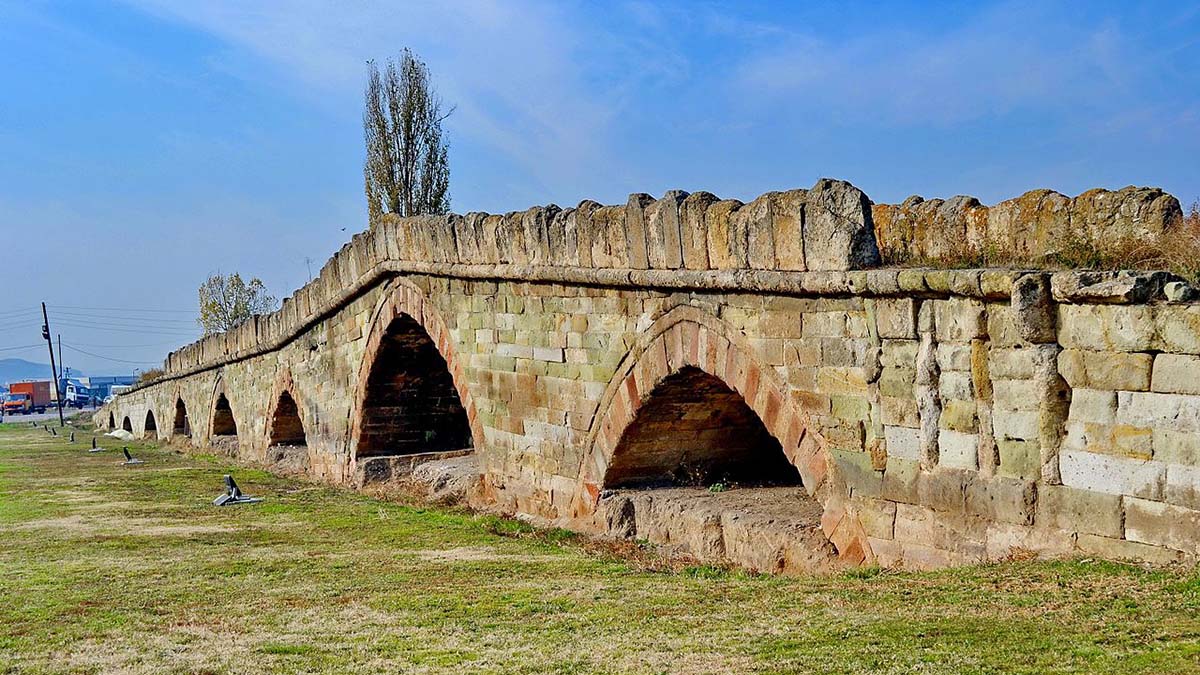
by Anthony Barilla
On the bus to Vushtrri (also spelled Vučitrn) I sat near the rear door with my legs hanging down into the entryway. An old man in a traditional white hat and three-piece suit sat next to me. His hands and fingers were covered in thick, black hair, and his face was mottled with age spots and reddened from the cold. He barked commands to the schoolchildren that clambered up the stairs before us, some of them grabbing onto my legs in lieu of a railing.
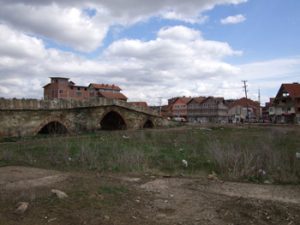 Outside the snow was falling very slowly, covering the fields and homes in a thin transparent veil. The sky matched the snow, consistently grey, and this pervading colorlessness brought the trash into starker contrast. There was not more trash, but the trash now seemed to be all there was, now that the fields had been harvested, the tractors had been parked beside the homes, the cows herded from the pasture and corralled around the haystacks. Plastic bags, empty bottles, broken slabs of concrete and trash bags filled every gully and drainage ditch. Newspapers and shredded tarps wrapped around tree branches at the edges of the streams, and the refuse seemed to be flowing upwards from every hole and indentation in the ground. Puddles of dirty water had iced over and trapped floating bottles in their thin surfaces, and the entire countryside was faded and discolored, broken only by the stark black rectangles of a thousand identical posters.
Outside the snow was falling very slowly, covering the fields and homes in a thin transparent veil. The sky matched the snow, consistently grey, and this pervading colorlessness brought the trash into starker contrast. There was not more trash, but the trash now seemed to be all there was, now that the fields had been harvested, the tractors had been parked beside the homes, the cows herded from the pasture and corralled around the haystacks. Plastic bags, empty bottles, broken slabs of concrete and trash bags filled every gully and drainage ditch. Newspapers and shredded tarps wrapped around tree branches at the edges of the streams, and the refuse seemed to be flowing upwards from every hole and indentation in the ground. Puddles of dirty water had iced over and trapped floating bottles in their thin surfaces, and the entire countryside was faded and discolored, broken only by the stark black rectangles of a thousand identical posters.
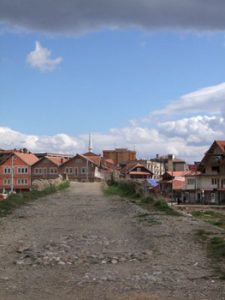 For reasons that I could not comprehend, a very famous rapper was scheduled to perform a concert in Pristina on Monday. This was not the usual regional idol, but an international superstar who could only be in the middle of a sellout tour of Europe. He would undoubtedly sell out his concert in Pristina as well: tickets were only five Euros, and I could not recall a star of his stature having appeared in Kosovo since I had lived there. Posters of his face had been plastered onto the walls of every crumbling shop and restaurant lining the road between Mitrovicë and Vushtrri. In each one, a grim 50 Cent stared directly into the camera, his hands clasping the sides of his head, jewelry encrusting his fingers. Perhaps there was nothing contradictory about 50 Cent in Kosovo. If he was half the capitalist he claimed to be, then selling tickets at the rate that the local economy would bear on an off-night in an entertainment-starved United Nations administered province made perfect sense. I would not be there to watch him recite his gangsta anthems to a stadium full of Albanians and U.N. workers, but I sat on the bus and imagined how that might feel. Occasionally a car passed us carrying an inch or two of snow on its roof, the driver descending from the mountains for market day in Vushtrri.
For reasons that I could not comprehend, a very famous rapper was scheduled to perform a concert in Pristina on Monday. This was not the usual regional idol, but an international superstar who could only be in the middle of a sellout tour of Europe. He would undoubtedly sell out his concert in Pristina as well: tickets were only five Euros, and I could not recall a star of his stature having appeared in Kosovo since I had lived there. Posters of his face had been plastered onto the walls of every crumbling shop and restaurant lining the road between Mitrovicë and Vushtrri. In each one, a grim 50 Cent stared directly into the camera, his hands clasping the sides of his head, jewelry encrusting his fingers. Perhaps there was nothing contradictory about 50 Cent in Kosovo. If he was half the capitalist he claimed to be, then selling tickets at the rate that the local economy would bear on an off-night in an entertainment-starved United Nations administered province made perfect sense. I would not be there to watch him recite his gangsta anthems to a stadium full of Albanians and U.N. workers, but I sat on the bus and imagined how that might feel. Occasionally a car passed us carrying an inch or two of snow on its roof, the driver descending from the mountains for market day in Vushtrri.
In Vushtrri, market day is always on Friday. I followed the old man down the steps and into the traffic circle, which was jammed with trucks, their beds piled with potatoes and other vegetables, but most of all—now that winter had begun—with cabbages. There were more cabbages there in the traffic circle than the village of Vushtrri could ever consume, but more trucks were arriving behind us, and they drove up onto the sidewalks and circled us like a wagon train under siege. I slipped between two of them and stood for a while on the old Turkish bridge, smoking in the cold until my lungs burned.
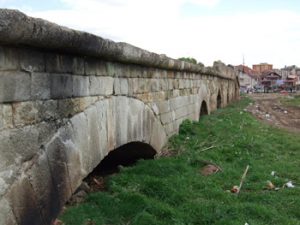 The bridge runs the length of a city block, and it rises out of a completely flat and barren field that shows no sign of ever having accommodated water of any kind. It sits on the edge of town, and it leads away into the empty distance. It is impossible to look upon without wondering, “Why is there a bridge built over nothing, and why does it lead nowhere?”
The bridge runs the length of a city block, and it rises out of a completely flat and barren field that shows no sign of ever having accommodated water of any kind. It sits on the edge of town, and it leads away into the empty distance. It is impossible to look upon without wondering, “Why is there a bridge built over nothing, and why does it lead nowhere?”
It is made of relatively evenly carved rectangular stones, and there are four or five small arches and a larger one at its base. The entire structure bends in a steeper incline on the end which leads into town, and arches are larger at this end, not, as you might expect, in the center. It has always been unclear to me whether this lopsided construction is the result of a design that intentionally mirrored the uneven banks of a long gone waterway, or if one end the bridge had been sinking for centuries into the field. In either case, the thick muddy ground of Kosovo had its way the Ottoman architects. The ground, and also the residents of Vushtrri, who even today still drag away stones from the top of the viaduct to use for their own purposes. I leaned over the edge and watched a farmer throwing blankets on the horses that he had tethered to a lone shrub growing there. His son emerged from one of the arches with an armload of discarded cardboard and paper; together they built a small fire beside their cart and set their backs against the bridge to protect themselves from the bitter wind.
Every part of the village is transformed by market day. One dirt road was filled with cattle, their hind legs and tails coated in drying mud. They were tied to the fences there, and a crowd of men strolled between the two rows. Hands reached out from the crowd to pat the cows’ asses. The cows and men ground the manure into the mud, and by late morning the road had become a liquid stream of thick mustard-colored water in which your boots sank.
As this road gave way to cobblestoned sidewalks and concrete, the livestock selection changed, as if one had moved from one section of a supermarket to the next. The sheep had been herded into makeshift pens that were only a short roll of barbed wire attached at both ends to the walls of a house. Inside some of the pens, the owners crouch in the cold among their flocks. The sheep all bore great curled horns, and they seemed like wild animals. Further along, chickens and roosters were tied by their legs to overturned crates, and they lay heaped together and immobile on their sides on the cold stone ground. Not every neighborhood has an established function on market day, but it is still market day everywhere on Friday in Vushtrri. Even the loneliest street corner will host a lone man standing beside a single bag of potatoes.
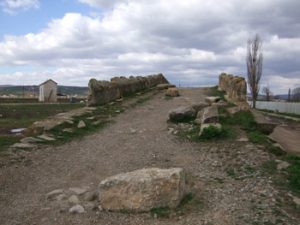 The first snowflakes appeared on the Thursday before market day in Vushtrri, and the temperature dropped steeply in the early afternoon. At night I lay on the couch and watched the BBC broadcast a television interview with Wolfgang Ischinger, the EU representative from the recently failed negotiations. The television program was called “Hardtalk,” a name its producers underscored with introductory graphics of liquid metal emerging from a furnace and slowly solidifying into eight eternal and immutable letters. For thirty minutes, the interviewer and his guest sat before a video display of glowing red molten magma while Ischinger drifted helplessly and dispassionately from question to question, seemingly unable to forestall even the most predictable objection that his incomplete responses would inevitably evoke. Every answer was countered by its obvious and inherent contradiction, each one deserving of an hour-long dissection. But “Hardtalk” only lasts for thirty minutes, and if I knew nothing about Kosovo when “Hardtalk” began, I would know less when it was over. I imagined shop owners in Frankfurt knitting their brows in frustration at Ischinger’s support for increased troops across the river from my apartment. I wanted to call them and explain, but of course I could do neither.
The first snowflakes appeared on the Thursday before market day in Vushtrri, and the temperature dropped steeply in the early afternoon. At night I lay on the couch and watched the BBC broadcast a television interview with Wolfgang Ischinger, the EU representative from the recently failed negotiations. The television program was called “Hardtalk,” a name its producers underscored with introductory graphics of liquid metal emerging from a furnace and slowly solidifying into eight eternal and immutable letters. For thirty minutes, the interviewer and his guest sat before a video display of glowing red molten magma while Ischinger drifted helplessly and dispassionately from question to question, seemingly unable to forestall even the most predictable objection that his incomplete responses would inevitably evoke. Every answer was countered by its obvious and inherent contradiction, each one deserving of an hour-long dissection. But “Hardtalk” only lasts for thirty minutes, and if I knew nothing about Kosovo when “Hardtalk” began, I would know less when it was over. I imagined shop owners in Frankfurt knitting their brows in frustration at Ischinger’s support for increased troops across the river from my apartment. I wanted to call them and explain, but of course I could do neither.
On the market day in Vushtrri before the 50 Cent concert, the snowfall steadily increased as the morning wore on. Dull white snowflakes drifted steadily into the open sacks of dull white flour. By three in the afternoon, our shoes and hooves were no longer enough to melt the encroaching blanket of snow from the sidewalk, and by nightfall the streets would be covered as well. Layers of trash would disappear beneath the snow, and Kosovo would become immaculately white and clean for at least a short while, with no garbage to contradict the streams and fields, no columns of poisonous smoke detectable against the dirty grey sky, no smell of burning plastic contradicting the sharp winter air. From the tinted windows of 50 Cent’s tour bus the entire region would appear simple, frozen and self-explanatory, with no room for questions about what was possible and what was not.
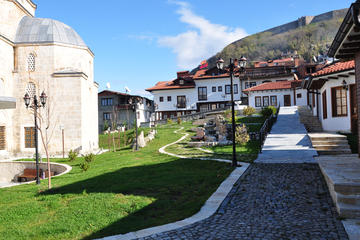
Kosovo Classic Multi-day Tour from Pristina
A Footnote On The Old Vushytrii Bridge:
“The change in the course of the Sitnica River at an undefined point, has significantly changed the function of the bridge from an active use to a passive use and as a monument of nostalgic as well as historic value.
The current physical condition of the bridge is poor. A number of its stone arches are dropping, substantial numbers of stones are missing from the parapet wall, and many of those that do exist, are in an accelerated form of decay. The stone surfaces are suffering from the effects of sulphation. The foundations of the bridge are not visible. A large proportion of the bridge is submerged in vegetation, debris and soil build up. Furthermore, buses park up against the side of the bridge and leave their engines running. Pollution from bus exhausts is adding to the deterioration of the soft stone.
Locals use the area to light fires of burning tyres and for dumping rubbish, all of which potentially add to the further deterioration of the bridge…
The fact that the stones are not considered worthy for salvage and construction elsewhere, has protected the bridge from being completely looted. Although the area is at risk from earthquakes, there are no visible signs of impact damage to the bridge.
The bridge is approximately 135 metres long and 6 metres wide. It is asymmetric; the eastern half is the oldest part, and consists of five pointed arches and the western end consists of four semicircular arches.
The stonework is very soft and there are at least four different types of stone present… A great number of stones are missing at parapet level (150 metres), falling out of position and are currently unstable, or are cracked. There are many large holes present in the side elevations of the bridge where birds are nesting.”
For further information visit: “The Stone Bridge, Vushtrri/Vucitrn, Kosovo/UNMIK, Integrated Rehabilitation Project Plan / Survey On The Architectural And Archaeological Heritage (IRPP/SAAH)”
Kosovo Tours Now Available:
Pristina Full-day Tour
Kosovo Day Trip: Pristina and Prizren Tour from Skopje
Kosovo Classic Multi-day Tour from Pristina
About the author:
Anthony Barilla is a composer, musician and theater artist from Texas. In 2007 he and his wife moved to Kosovo, where he founded Blackbird Books [blackbirdbookskosovo.blogspot.com], a non-profit library, bookstore and café. He gives away his own music for free at truesongs.blogspot.com, and he writes about Kosovo at kosovotravelogue.blogspot.com.
Contact: kosovotravelogue@gmail.com
Photo Credits:
First Vojinović Bridge photo – Ura e Vjetër e Gurit në Vushtrri – by ShkelzenRexha / CC BY-SA
All other photos are by Anthony Barilla.


